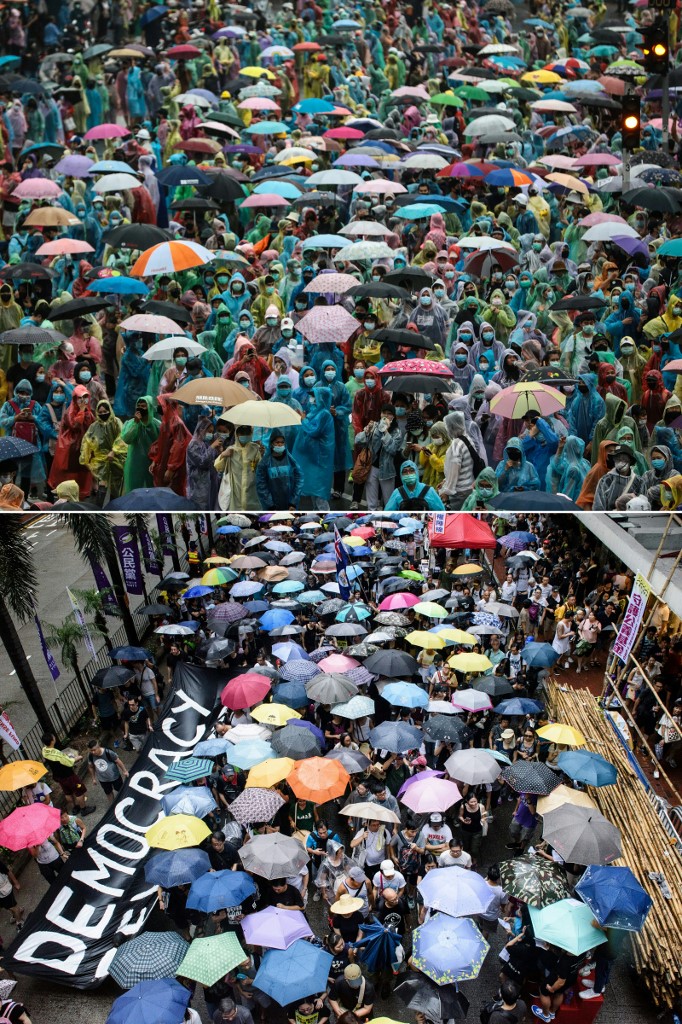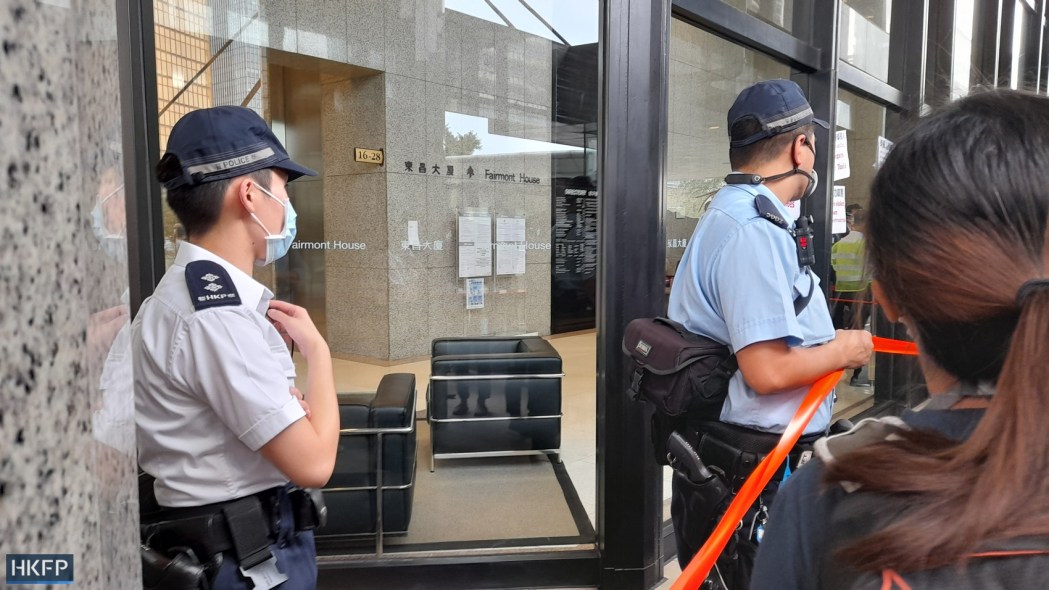Young and restless: Hong Kong and Thailand protest parallels
Hong Kong and Thailand have both seen their streets filled with protesters daring to take on an entrenched political elite, and to discuss once-taboo subjects in their push for greater freedoms.
Voranai Vanijaka, a political analyst at Bangkok’s Thammasat University, said tech-savvy youths in both territories have “shared cultural values”.
by AFP, 19 OCTOBER 2020
By Dene-Hern Chen with Jerome Taylor in Hong Kong

This combination of file pictures created on October 19, 2020 shows (top) pro-democracy protesters wearing helmets and holding umbrellas during an anti-government rally in Bangkok on October 18, 2020, and (bottom) protesters wearing helmets and holding umbrellas to shield themselves from tear gas during a protest in Hong Kong on July 27, 2019. Photo: Lillian Suwanrumpha and Philip Fong/AFP.
“(It’s) the love for freedom and the courage to fight for change,” he told AFP.
Here are five similarities.
Taking on powerful targets
Both movements are primarily motivated by inequality and democracy, but in pushing for a greater say in how their fates are forged they are taking on formidable foes resistant to change.

This combination of file pictures created on October 19, 2020 shows (top) pro-democracy protesters holding up flashlights on their phones during an anti-government rally in Bangkok on October 18, 2020, and (bottom) protesters holding up flashlights on their phones during a rally in Hong Kong on October 19, 2019. Photo: Mladen Antonov and Ed Jones/AFP.
For Hong Kong, it is the Chinese Communist Party, which crushes dissent on the mainland and has increased control over the restless semi-autonomous city.
Beijing has rejected calls for greater democracy and police accountability, and has since blanketed the finance hub in a national security law that has, for the meantime, snuffed out mass dissent.
In Thailand, it is the monarchy – backed by the powerful, coup-prone military – that sits at the apex of the political pyramid
.
This combination of file pictures created on October 19, 2020 shows (top) pro-democracy protesters holding up flashlights on their phones during a demonstration in Bangkok on October 15, 2020, and (bottom) people holding up flashlights on their phones during a rally thanking US President Donald Trump for signing legislation requiring an annual review of freedoms in Hong Kong on November 28, 2019. Photo: Jack Taylor and Anthony Wallace/AFP.
For now, it is unclear how the palace will react to the Thai protests, but in previous periods of turbulence it has played a pivotal role in deciding the outcome.
Rule of law or rule by law?
The way authorities use the law have been key catalysts.
The initial spark in Hong Kong was an eventually aborted attempt to allow extraditions to the authoritarian mainland’s party-controlled courts.
The protest movement then morphed into a wider push for universal suffrage and opposition to Beijing’s rule.

This combination of file pictures created on October 19, 2020 shows (top) pro-democracy protesters giving the three-finger salute as they gather for a demonstration in Bangkok on October 15, 2020, and (bottom) demonstrators holding up their hands to symbolise the five demands that protesters are asking for during a march in Hong Kong on September 8, 2019. Photo: Jack Taylor and Vivek Prakash/AFP,
In Thailand, the kingdom’s draconian lese majeste law – which shields the monarchy from criticism – has been a crucial component of calls for reform, as well as prosecutions under broadly-worded sedition and cybercrime laws.
Multiple critics of the Thai monarchy have also disappeared, with Human Rights Watch recording at least nine cases involving activists overseas.
The current round of protests came after activist Wanchalearm Satsaksit was allegedly kidnapped in Cambodia in June. He hasn’t been seen since.
Youth-led
Youngsters are at the heart of calls for reform
.
This combination of file pictures created on October 19, 2020 shows (top) pro-democracy protesters carrying sections of a metal barrier during an anti-government rally in Bangkok on October 18, 2020, and (bottom) protesters carrying sections of a metal barrier during a pro-democracy march in Hong Kong on October 20, 2019. Photo: Jack Taylor and Anthony Wallace/AFP.
Hong Kong’s huge rallies represented a broad swathe of society, from students to lawyers, bus drivers, civil servants and teachers.
But the frontline activists – and those embracing increasingly violent tactics – were overwhelmingly young. Many face prosecution and years in jail.
Some of Hong Kong’s most visible activists, such as Joshua Wong and Agnes Chow, were teenagers when they first got involved in politics.
Thailand’s protest leaders – most of whom have been arrested in the last week – are in their early twenties and are similarly more willing to embrace confrontational tactics than older generations.
Taboos shattered
Taboo topics have been thrust centre stage
. 
This combination of file pictures created on October 19, 2020 shows (top) pro-democracy protesters sheltering under umbrellas during an anti-government rally in Bangkok on October 18, 2020, and (bottom) protesters holding up umbrellas during a protest march in Hong Kong on July 1, 2017. Photo: Jack Taylor and Anthony Wallace/AFP.
In Hong Kong, young activists were far more willing to embrace the idea of autonomy and even outright independence from China – a concept that remains a red line for Beijing.
As the protests dragged and authorities refused major concessions, chants and flags declaring “Liberate Hong Kong, revolution of our times” became commonplace.
In Thailand, even talking about the concept of reforming the monarchy is enough to land someone in jail.
But people have begun to lose that fear.
Young activists have given speeches for the lese majeste law to be abolished and called for the king’s huge personal wealth – estimated to be some US$60 billion – to have a clear division of assets between public and personal.
Protest tactics
Thai protesters donned hard hats, goggles, gas masks and umbrellas against water cannon over the weekend in images that could have come straight out of Hong Kong last year.
This combination of file pictures created on October 19, 2020 shows (top) police using water cannons to disperse pro-democracy protesters during an anti-government rally in Bangkok on October 16, 2020, and (bottom) pro-democracy protesters reacting as police fire water cannons outside the government headquarters in Hong Kong on September 15, 2019. Photo: Mladen Antonov and Nicolas Asfouri/AFP.
Young activists in both places have also swapped tactics online and offered messages of support.
Both movements are using encrypted social messaging platforms to mobilise, and have opted for flashmob rallies – especially since authorities arrested key leaders.
Hand symbols have also taken centre stage.
In Hong Kong, a raised palm symbolises the “Five demands, not one less” slogan.
Credit to instagram @hk90s__photolifes
Below: Thailand
From here: https://t.co/jAgANxItQT pic.twitter.com/2yOwe9bvhO— Grace Tsoi (@gracehw) October 18, 2020
The Thais meanwhile have embraced a three-finger salute from the dystopian movie “The Hunger Games”.
Analyst Voranai said Thai protesters are currently “much less radical than their Hong Kong counterparts”.
Graffiti in support of the #Thailand protests has appeared in Hong Kong. The two resistance movements have been linked under what activists have called the #MilkTeaAlliance. Photo: @studioincendo. pic.twitter.com/ZsVJmANSfu— Hong Kong Free Press HKFP (@hkfp) October 18, 2020
“But at the core, it’s the same: freedom.”



























 (@joshuawongcf)
(@joshuawongcf) 
